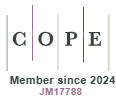Network analysis for identifying potential anti-virulence targets from whole transcriptome of Pseudomonas aeruginosa and Staphylococcus aureus exposed to certain anti-pathogenic polyherbal formulations
DOI:
https://doi.org/10.33393/dti.2023.2595Keywords:
AMR (antimicrobial resistance), Anti-virulence, Network Analysis, Novel antibacterial targets, Polyherbal, Protein-Protein Interaction (PPI)Abstract
Introduction: Antimicrobial resistance (AMR) is a serious global threat. Identification of novel antibacterial targets is urgently warranted to help antimicrobial drug discovery programs. This study attempted identification of potential targets in two important pathogens Pseudomonas aeruginosa and Staphylococcus aureus.
Methods: Transcriptomes of P. aeruginosa and S. aureus exposed to two different quorum-modulatory polyherbal formulations were subjected to network analysis to identify the most highly networked differentially expressed genes (hubs) as potential anti-virulence targets.
Results: Genes associated with denitrification and sulfur metabolism emerged as the most important targets in P. aeruginosa. Increased buildup of nitrite (NO2) in P. aeruginosa culture exposed to the polyherbal formulation Panchvalkal was confirmed through in vitro assay too. Generation of nitrosative stress and inducing sulfur starvation seemed to be effective anti-pathogenic strategies against this notorious gram-negative pathogen. Important targets identified in S. aureus were the transcriptional regulator sarA, immunoglobulin-binding protein Sbi, serine protease SplA, the saeR/S response regulator system, and gamma-hemolysin components hlgB and hlgC.
Conclusion: Further validation of the potential targets identified in this study is warranted through appropriate in vitro and in vivo assays in model hosts. Such validated targets can prove vital to many antibacterial drug discovery programs globally.
References
- Årdal C, Baraldi E, Theuretzbacher U, et al. Insights into early stage of antibiotic development in small- and medium-sized enterprises: a survey of targets, costs, and durations. J Pharm Policy Pract. 2018;11(1):8;1-10. https://doi.org/10.1186/s40545-018-0135-0 PMID:29632669 DOI: https://doi.org/10.1186/s40545-018-0135-0
- Årdal C, Balasegaram M, Laxminarayan R, et al. Antibiotic development – economic, regulatory and societal challenges. Nat Rev Microbiol. 2020;18(5):267-274. https://doi.org/10.1038/s41579-019-0293-3 PMID:31745330 DOI: https://doi.org/10.1038/s41579-019-0293-3
- Prasad NK, Seiple IB, Cirz RT, Rosenberg OS. Leaks in the pipeline: a failure analysis of gram-negative antibiotic development from 2010 to 2020. Antimicrob Agents Chemother. 2022;66(5):1-18. https://doi.org/10.1128/aac.00054-22 PMID:35471042 DOI: https://doi.org/10.1128/aac.00054-22
- Årdal C, Baraldi E, Busse R, et al. Transferable exclusivity voucher: a flawed incentive to stimulate antibiotic innovation. Lancet. 2023;S0140-6736(23)00282-9. https://doi.org/10.1016/S0140-6736(23)00282-9 PMID:36774936 DOI: https://doi.org/10.1016/S0140-6736(23)00282-9
- Laxminarayan R, Duse A, Wattal C, et al. Antibiotic resistance – the need for global solutions. Lancet Infect Dis. 2013;13(12):1057-1098. https://doi.org/10.1016/S1473-3099(13)70318-9 PMID:24252483 DOI: https://doi.org/10.1016/S1473-3099(13)70318-9
- Cheng G, Dai M, Ahmed S, Hao H, Wang X, Yuan Z. Antimicrobial drugs in fighting against antimicrobial resistance. Front Microbiol. 2016;7:470. https://doi.org/10.3389/fmicb.2016.00470 PMID:27092125 DOI: https://doi.org/10.3389/fmicb.2016.00470
- Silver LL. Challenges of antibacterial discovery. Clin Microbiol Rev. 2011;24(1):71-109. https://doi.org/10.1128/CMR.00030-10 PMID:21233508 DOI: https://doi.org/10.1128/CMR.00030-10
- Kenny JG, Ward D, Josefsson E, et al. The Staphylococcus aureus response to unsaturated long chain free fatty acids: survival mechanisms and virulence implications. PLoS One. 2009;4(2):e4344. https://doi.org/10.1371/journal.pone.0004344 PMID:19183815 DOI: https://doi.org/10.1371/journal.pone.0004344
- Langendonk RF, Neill DR, Fothergill JL. The building blocks of antimicrobial resistance in Pseudomonas aeruginosa: implications for current resistance-breaking therapies. Front Cell Infect Microbiol. 2021;11:665759. https://doi.org/10.3389/fcimb.2021.665759 PMID:33937104 DOI: https://doi.org/10.3389/fcimb.2021.665759
- Joshi C, Patel P, Palep H, Kothari V. Validation of the anti-infective potential of a polyherbal ‘Panchvalkal’ preparation, and elucidation of the molecular basis underlining its efficacy against Pseudomonas aeruginosa. BMC Complement Altern Med. 2019;19(1):19. https://doi.org/10.1186/s12906-019-2428-5 PMID:30654785 DOI: https://doi.org/10.1186/s12906-019-2428-5
- Patel P, Joshi C, Kothari V. Anti-pathogenic efficacy and molecular targets of a polyherbal wound-care formulation (Herboheal) against Staphylococcus aureus. Infect Disord Drug Targets. 2019;19(2):193-206. https://doi.org/10.2174/1871526518666181022112552 PMID:30345928 DOI: https://doi.org/10.2174/1871526518666181022112552
- Szklarczyk D, Gable AL, Lyon D, et al. STRING v11: protein-protein association networks with increased coverage, supporting functional discovery in genome-wide experimental datasets. Nucleic Acids Res. 2019;47(D1):D607-D613. https://doi.org/10.1093/nar/gky1131 PMID:30476243 DOI: https://doi.org/10.1093/nar/gky1131
- Chin CH, Chen SH, Wu HH, Ho CW, Ko MT, Lin CY. cytoHubba: identifying hub objects and sub-networks from complex interactome. BMC Syst Biol. 2014;8(Suppl 4):S11. https://doi.org/10.1186/1752-0509-8-S4-S11 PMID:25521941 DOI: https://doi.org/10.1186/1752-0509-8-S4-S11
- Misko TP, Schilling RJ, Salvemini D, Moore WM, Currie MG. A fluorometric assay for the measurement of nitrite in biological samples. Anal Biochem. 1993;214(1):11-16. https://doi.org/10.1006/abio.1993.1449 PMID:7504409 DOI: https://doi.org/10.1006/abio.1993.1449
- Joshi C, Kothari V, Patel P. Importance of selecting appropriate wavelength, while quantifying growth and production of quorum sensing regulated pigments in bacteria. Recent Pat Biotechnol. 2016;10(2):145-152. https://doi.org/10.2174/1872208310666160414102848 PMID:27076088 DOI: https://doi.org/10.2174/1872208310666160414102848
- Barraud N, Hassett DJ, Hwang SH, Rice SA, Kjelleberg S, Webb JS. Involvement of nitric oxide in biofilm dispersal of Pseudomonas aeruginosa. J Bacteriol. 2006;188(21):7344-7353. https://doi.org/10.1128/JB.00779-06 PMID:17050922 DOI: https://doi.org/10.1128/JB.00779-06
- Barnes RJ, Bandi RR, Wong WS, et al. Optimal dosing regimen of nitric oxide donor compounds for the reduction of Pseudomonas aeruginosa biofilm and isolates from wastewater membranes. Biofouling. 2013;29(2):203-212. https://doi.org/10.1080/08927014.2012.760069 PMID:23368407 DOI: https://doi.org/10.1080/08927014.2012.760069
- Fida TT, Voordouw J, Ataeian M, et al. Synergy of sodium nitroprusside and nitrate in inhibiting the activity of sulfate reducing bacteria in oil-containing bioreactors. Front Microbiol. 2018;9:981. https://doi.org/10.3389/fmicb.2018.00981 PMID:29867883 DOI: https://doi.org/10.3389/fmicb.2018.00981
- Arai H. Regulation and function of versatile aerobic and anaerobic respiratory metabolism in Pseudomonas aeruginosa. Front Microbiol. 2011;2:103. https://doi.org/10.3389/fmicb.2011.00103 PMID:21833336 DOI: https://doi.org/10.3389/fmicb.2011.00103
- Adamczack J, Hoffmann M, Papke U, et al. NirN protein from Pseudomonas aeruginosa is a novel electron-bifurcating dehydrogenase catalyzing the last step of heme d1 biosynthesis. J Biol Chem. 2014;289(44):30753-30762. https://doi.org/10.1074/jbc.M114.603886 PMID:25204657 DOI: https://doi.org/10.1074/jbc.M114.603886
- Dettman JR, Rodrigue N, Aaron SD, Kassen R. Evolutionary genomics of epidemic and nonepidemic strains of Pseudomonas aeruginosa. Proc Natl Acad Sci USA. 2013;110(52):21065-21070. https://doi.org/10.1073/pnas.1307862110 PMID:24324153 DOI: https://doi.org/10.1073/pnas.1307862110
- Borrero-de Acuña JM, Timmis KN, Jahn M, Jahn D. Protein complex formation during denitrification by Pseudomonas aeruginosa. Microb Biotechnol. 2017;10(6):1523-1534. https://doi.org/10.1111/1751-7915.12851 PMID:28857512 DOI: https://doi.org/10.1111/1751-7915.12851
- Tralau T, Vuilleumier S, Thibault C, Campbell BJ, Hart CA, Kertesz MA. Transcriptomic analysis of the sulfate starvation response of Pseudomonas aeruginosa. J Bacteriol. 2007;189(19):6743-6750. https://doi.org/10.1128/JB.00889-07 PMID:17675390 DOI: https://doi.org/10.1128/JB.00889-07
- Marquordt C, Fang Q, Will E, Peng J, von Figura K, Dierks T. Posttranslational modification of serine to formylglycine in bacterial sulfatases. Recognition of the modification motif by the iron-sulfur protein AtsB. J Biol Chem. 2003;278(4):2212-2218. https://doi.org/10.1074/jbc.M209435200 PMID:12419807 DOI: https://doi.org/10.1074/jbc.M209435200
- Hummerjohann J, Laudenbach S, Rétey J, Leisinger T, Kertesz MA. The sulfur-regulated arylsulfatase gene cluster of Pseudomonas aeruginosa, a new member of the cys regulon. J Bacteriol. 2000;182(7):2055-2058. https://doi.org/10.1128/JB.182.7.2055-2058.2000 PMID:10715018 DOI: https://doi.org/10.1128/JB.182.7.2055-2058.2000
- Kakishima K, Shiratsuchi A, Taoka A, Nakanishi Y, Fukumori Y. Participation of nitric oxide reductase in survival of Pseudomonas aeruginosa in LPS-activated macrophages. Biochem Biophys Res Commun. 2007;355(2):587-591. https://doi.org/10.1016/j.bbrc.2007.02.017 PMID:17307144 DOI: https://doi.org/10.1016/j.bbrc.2007.02.017
- Gusarov I, Nudler E. NO-mediated cytoprotection: instant adaptation to oxidative stress in bacteria. Proc Natl Acad Sci USA. 2005;102(39):13855-13860. https://doi.org/10.1073/pnas.0504307102 PMID:16172391 DOI: https://doi.org/10.1073/pnas.0504307102
- Gusarov I, Shatalin K, Starodubtseva M, Nudler E. Endogenous nitric oxide protects bacteria against a wide spectrum of antibiotics. Science. 2009;325(5946):1380-1384. https://doi.org/10.1126/science.1175439 PMID:19745150 DOI: https://doi.org/10.1126/science.1175439
- Rinaldo S, Giardina G, Mantoni F, Paone A, Cutruzzolà F. Beyond nitrogen metabolism: nitric oxide, cyclic-di-GMP and bacterial biofilms. FEMS Microbiol Lett. 2018;365(6). https://doi.org/10.1093/femsle/fny029 PMID:29401255 DOI: https://doi.org/10.1093/femsle/fny029
- Barraud N, Kelso MJ, Rice SA, Kjelleberg S. Nitric oxide: a key mediator of biofilm dispersal with applications in infectious diseases. Curr Pharm Des. 2015;21(1):31-42. https://doi.org/10.2174/1381612820666140905112822 PMID:25189865 DOI: https://doi.org/10.2174/1381612820666140905112822
- Plate L, Marletta MA. Nitric oxide modulates bacterial biofilm formation through a multicomponent cyclic-di-GMP signaling network. Mol. Cell. 2012 ;449-560. https://doi.org/10.1016/j.molcel.2012.03.023 DOI: https://doi.org/10.1016/j.molcel.2012.03.023
- Schairer DO, Chouake JS, Nosanchuk JD, Friedman AJ. The potential of nitric oxide releasing therapies as antimicrobial agents. Virulence. 2012;3(3):271-279. https://doi.org/10.4161/viru.20328 PMID:22546899 DOI: https://doi.org/10.4161/viru.20328
- Small DA, Chang W, Toghrol F, Bentley WE. Toxicogenomic analysis of sodium hypochlorite antimicrobial mechanisms in Pseudomonas aeruginosa. Appl Microbiol Biotechnol. 2007;74(1):176-185. https://doi.org/10.1007/s00253-006-0644-7 PMID:17021869 DOI: https://doi.org/10.1007/s00253-006-0644-7
- Eichhorn E, van der Ploeg JR, Leisinger T. Deletion analysis of the Escherichia coli taurine and alkanesulfonate transport systems. J Bacteriol. 2000;182(10):2687-2695. https://doi.org/10.1128/JB.182.10.2687-2695.2000 PMID:10781534 DOI: https://doi.org/10.1128/JB.182.10.2687-2695.2000
- Small DA, Chang W, Toghrol F, Bentley WE. Comparative global transcription analysis of sodium hypochlorite, peracetic acid, and hydrogen peroxide on Pseudomonas aeruginosa. Appl Microbiol Biotechnol. 2007;76(5):1093-1105. https://doi.org/10.1007/s00253-007-1072-z PMID:17624526 DOI: https://doi.org/10.1007/s00253-007-1072-z
- Stec-Niemczyk J, Pustelny K, Kisielewska M, et al. Structural and functional characterization of SplA, an exclusively specific protease of Staphylococcus aureus. Biochem J. 2009;419(3):555-564. https://doi.org/10.1042/BJ20081351 PMID:19175361 DOI: https://doi.org/10.1042/BJ20081351
- Burman JD, Leung E, Atkins KL, et al. Interaction of human complement with Sbi, a staphylococcal immunoglobulin-binding protein: indications of a novel mechanism of complement evasion by Staphylococcus aureus. J Biol Chem. 2008;283(25):17579-17593. https://doi.org/10.1074/jbc.M800265200 PMID:18434316 DOI: https://doi.org/10.1074/jbc.M800265200
- Guerra FE, Addison CB, de Jong NW, et al. Staphylococcus aureus SaeR/S-regulated factors reduce human neutrophil reactive oxygen species production. J Leukoc Biol. 2016;100(5):1005-1010. https://doi.org/10.1189/jlb.4VMAB0316-100RR PMID:27334228 DOI: https://doi.org/10.1189/jlb.4VMAB0316-100RR
- Guerra FE, Borgogna TR, Patel DM, Sward EW, Voyich JM. Epic immune battles of history: neutrophils vs. Staphylococcus aureus. Front Cell Infect Microbiol. 2017;7:286. https://doi.org/10.3389/fcimb.2017.00286 PMID:28713774 DOI: https://doi.org/10.3389/fcimb.2017.00286
- Wilson M. Microbial inhabitants of humans: Their ecology and role in health and disease. Cambridge University Press 2005;15:chap 1. DOI: https://doi.org/10.1017/CBO9780511735080
- Muñoz KA, Hergenrother PJ. Facilitating compound entry as a means to discover antibiotics for gram-negative bacteria. Acc Chem Res. 2021;54(6):1322-1333. https://doi.org/10.1021/acs.accounts.0c00895 PMID:33635073 DOI: https://doi.org/10.1021/acs.accounts.0c00895










